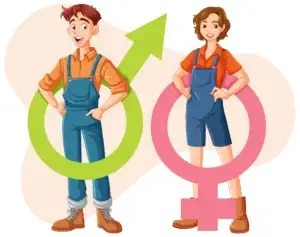Understanding the words we often hear—but may not fully understand
In everyday conversations, the words sex, gender, and sexuality are often used interchangeably. But while they’re related, they actually describe very different aspects of who we are as human beings.
Understanding these differences is not only helpful—it’s essential for respectful communication, self-awareness, and creating inclusive communities. Whether you’re exploring your own identity or simply want to better understand others, this guide will help clear up the confusion in a straightforward and respectful way.

1. What Is Sex?
Sex refers to the biological characteristics a person is born with. This includes physical traits like reproductive organs, chromosomes (such as XX or XY), and hormone levels.
Traditionally, people are assigned male or female at birth based on these traits. However, some people are born intersex, meaning their biology doesn’t fit neatly into typical definitions of male or female. This is completely natural and more common than many people realize.
In short:
Sex = Biological traits you’re born with (male, female, intersex)
2. What Is Gender?
Gender is not the same as sex. It refers to the social and cultural roles, behaviors, and expectations that a society considers appropriate for men, women, or other gender identities.
For example, in many cultures, people are expected to act or dress a certain way depending on whether they’re male or female. But gender goes beyond that—it includes how someone feels and identifies on the inside.
Some common gender identities include:
-
Man / Woman (aligned with traditional ideas of male and female)
-
Transgender (when someone’s gender identity is different from the sex assigned at birth)
-
Non-binary, genderqueer, or genderfluid (identities beyond just “man” or “woman”)
Gender is a personal experience and may not always match the biological sex someone was assigned at birth.
In short:
Gender = How someone personally identifies and expresses themselves in society
3. What Is Sexuality?
Sexuality, or sexual orientation, refers to who someone is emotionally, romantically, or physically attracted to. It’s about how people form intimate connections—regardless of their sex or gender.
Some common types of sexual orientation include:
-
Heterosexual (attracted to a different gender)
-
Homosexual (gay or lesbian – attracted to the same gender)
-
Bisexual (attracted to more than one gender)
-
Asexual (experiencing little or no sexual attraction)
-
Pansexual (attracted to people regardless of gender)
Just like gender, sexuality exists on a spectrum and can be fluid—meaning it may change over time for some people.
In short:
Sexuality = Who someone is attracted to emotionally and/or romantically
Why These Differences Matter
Understanding the difference between sex, gender, and sexuality helps us:
-
Respect people’s identities and experiences
-
Avoid assumptions or stereotypes
-
Communicate more clearly and kindly
-
Support others and ourselves in living authentically
Final Thoughts
These terms—sex, gender, and sexuality—describe different parts of what makes us human. While they may seem confusing at first, taking the time to learn and use them correctly shows respect and understanding for others and ourselves.
We all deserve to be seen, heard, and accepted for who we are. And it starts with education.
